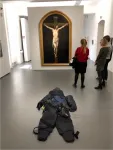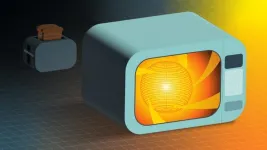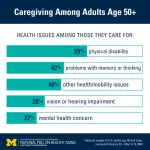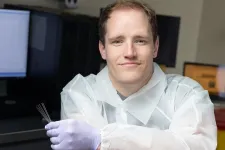(Press-News.org) A new study by an international team of collaborators led by researchers at the University of Vienna, and in collaboration with the Dom Museum Wien, aimed to address the questions of whether art exhibitions can make us more empathic or even change our attitudes and behaviors? The researchers were able to show that, indeed, looking through the exhibition reduced xenophobia and increased acceptance of immigration. Even more, by employing a new cellphone-based experience sampling method, they could track how long these changes last. The study was recently published in the American Psychological Association Journal Psychology of Aesthetics, Creativity, and the Arts.
"The question of how art might make us more conscious and empathic citizens or modify people’s responses towards societal challenge such as climate change, refugees, is a growing interest for art institutions, artists, and for municipalities and cultural policy makers", says Matthew Pelowski from the Faculty of Psychology, University of Vienna, lead author of the project. Klaus Speidel, one of the curators of the show adds, "in recent years, there has been a shift in how we view art in our societies. The arts are no longer seen as purely recreational, but rather as a powerful, and often untapped, resource for health, learning, and personal or societal well-being." However, Pelowski also suggests, "despite high interest, there is surprisingly little data on whether visiting an exhibition or viewing an artwork really does anything, especially regarding its effect on how we think and behave. How long effects might last or what kind of effects we might find are entirely unknown."
To answer these questions, the research team assessed visitors’ experiences for the exhibition, "Show Me Your Wound" (Zeig mir deine Wunde), curated by Johanna Schwanberg and Klaus Speidel at Dom Museum Wien. The exhibition used a blend of contemporary and historical art to focus on the topic of vulnerability. Through the exhibition, the curators aimed to "encourage visitors to reflect on a crucial issue of humankind” and to "bring about positive change".
These aims were tested in two ways: Researchers first stopped people walking by the museum and asked if they would like to participate in exchange for a free ticket. Visitors were asked to report on their thoughts and feelings regarding their empathic concern for others and their feelings of xenophobia or willingness to accept refugees into their country – both immediately before and after the visit. This showed that, indeed, the exhibition reduced xenophobia and increased acceptance in visitors. At the same time, this acute effect also opened further questions for the research team regarding how effects might impact the everyday life of museum visitors after they leave, and how long impacts might last.
Therefore, the research team also used an experience sampling method (ESM) technique with the same exhibition, in which a second group of 41 people installed an app on their mobile phones and reported on their thoughts and actions each day. Researchers tracked responses for two weeks, with the visit to the exhibition at the mid-point. When comparing the period before the visit to the period after, the results showed that participants reported that they had tried to think and act more socially and openly and to help others more following their visit to the exhibition. Most of these changes lasted for the rest of the day. However, people also reported ‘trying to consider others feelings’ and ‘reflecting more about themselves’ for the following week.
"These results provide some of the first evidence that even a brief visit to an exhibition, especially one using contemporary art to target an emerging societal challenge, can make a detectable, lasting change," noted Pelowski. Even when the impact has a shorter duration, it still is positive. Pelowski adds: "If we think about all of the thousands of people who might visit an exhibition, if everyone thinks a little bit more of others or tries to be more open and accepting for that day, that can lead to a powerful, cumulative effect." The fact that people did try to think of others and were more reflective for up to a week is also exciting evidence for the kind of role that the arts might indeed play in society and for why this needs to be a topic for future investigation.
The project also provides important evidence on the topic of arts as a tool for addressing attitudes about immigration and refugees, which is an emerging focus as curators and artists try to respond to worldwide geopolitical events. "The current Venice Biennale, for example, which has the title of 'Foreigners Everywhere,' has been the topic of a large number of recent discussions around the impact of arts on people’s mindset regarding immigration. Our study now strongly supports the idea of exhibitions being a reliable tool to shed light on social issues", says Pelowski.
The project, in which curators and researchers worked together to develop the study, also represented a new type of collaboration bridging researchers and art institutions. "Previously, it has really been rare to have the opportunity to have such amazing access and to work collaboratively with art institutions and to bring together a diverse group of perspectives," noted Pelowski. "Dom Museum Wien, as well as several institutions in Vienna, really represents an exciting new approach to the arts and to collaborative research".
Currently, the research- and curatorial team is planning another study involving a new exhibition, "Being Mortal/Sterblich sein", which considers how individuals and society deal with mortality, and how the arts may provide a powerful opportunity for insight and reflection on this topic. The exhibition is on view from until August 25, 2024 at the Dom Museum Wien.
END
Visiting an art exhibition can make you think more socially and openly. But for how long?
Vienna Scientists find that visiting an art exhibition can make people more reflective and willing to help others for up to a week
2024-08-06
ELSE PRESS RELEASES FROM THIS DATE:
Heating for fusion: Why toast plasma when you can microwave it!
2024-08-06
Some believe the future of fusion in the U.S. lies in compact, spherical fusion vessels. A smaller tokamak, it is thought, could offer a more economical fusion option. The trick is squeezing everything into a small space. New research suggests eliminating one major component used to heat the plasma, freeing up much-needed space.
Scientists at the U.S. Department of Energy’s (DOE) Princeton Plasma Physics Laboratory (PPPL), the private company Tokamak Energy and Kyushu University in Japan have proposed a design for a compact, spherical fusion pilot plant ...
Nudges fail to motivate vaccination
2024-08-06
One popular strategy to motivate people to get vaccinated is the nudge—a message designed to take advantage of human tendencies to conform to social norms, seek to protect loved ones or community, and to prefer treatments with high efficacy rates. Jiseon Chang and colleagues sought to assess the efficacy of such nudges in real world contexts during the COVID-19 pandemic. The authors paid for ads to appear on Facebook between October 2021 and January 2022, reaching almost 15 million users in Brazil, Russia, South Africa, Taiwan, ...
Caregiving: Poll reveals who’s providing care and who they’re caring for
2024-08-06
More than 1 in 4 people age 50 and older helps take care of at least one family member or friend who has a health problem or disability, a new poll finds.
And among those caregivers, the new results from the University of Michigan National Poll on Healthy Aging reveal a lot about who they are and who they’re caring for.
In all, 30% of all people in their 50s and early 60s provide care to at least one person with a health issue or disability, compared with 23% of people over 65. And 1 in 10 caregivers in their 50s and early 60s are juggling taking care of three or more people.
In ...
To predict tax revenue, look at corporate earnings
2024-08-06
To Predict Tax Revenue, Look at Corporate Earnings
States can make more accurate budget forecasts and avoid midyear cuts if they include growth in corporate earnings
AUSTIN, Texas -- In the complex task of building a state budget, much rides on the accuracy of its fiscal crystal ball: its forecast of how much tax revenue will come in to fund services during the year ahead. Forecasting errors have increased since 2001 due to revenue volatility, such as wider swings in personal income and consumer spending.
New research from Texas ...
New visual technique could advance early detection of neurodegenerative diseases
2024-08-06
MINNEAPOLIS / ST. PAUL (08/06/2024) — Researchers at the University of Minnesota, have developed a new visual diagnostic technique that can be used to advance early detection for neurodegenerative diseases like Parkinson's disease and similar diseases that affect animals, including Chronic Wasting Disease in deer.
The research is published in npj Biosensing, a peer-reviewed scientific journal published by Nature.
Named Cap-QuIC (Capillary-enhanced Quaking-Induced Conversion), researchers will now be able to distinguish infected samples with the naked eye, which makes testing ...
ALS diagnosis and survival linked to metals in blood, urine
2024-08-06
People with higher levels of metals found in their blood and urine may be more likely to be diagnosed with — and die from — amyotrophic lateral sclerosis, or ALS, a University of Michigan-led study suggests.
Researchers have known that ALS, a rare but fatal neurodegenerative condition, is influenced by genetic and environmental factors, including exposure to pesticides and metals.
This latest study examined the levels of metals in the blood and urine of people with and without ALS, finding that exposure to individual and mixtures of metals is associated with a greater risk for ALS and shorter survival.
The ...
Anxiety reframed can make business pitches more effective
2024-08-06
PULLMAN, Wash. – It may be possible to turn anxiety into a superpower in some scenarios, recent research with entrepreneurs indicates.
A Washington State University-led study found that if entrepreneurs preparing to make a funding pitch connected their pitch anxiety to their passion for their venture, judges ranked their performance higher. Perhaps even more importantly, the judges were also more likely to recommend them for funding.
This emotion reframing involved the entrepreneurs recognizing that they were feeling anxious partly because the project means so much to them. Entrepreneurs who tried other strategies ...
Study finds refined corn flour with added corn bran can lower cholesterol
2024-08-06
The findings of the randomized crossover clinical trial, available online now and slated to appear in an upcoming issue of the Journal of Nutrition, reveal simply swapping in foods made from refined corn flour + corn bran can lower LDL cholesterol concentrations by anywhere from 5% - 13.3% in just four weeks.
The trial compared the impact of whole-grain corn meal, refined corn meal, and a blend (refined corn meal plus corn bran) and found that 70% of the participants saw significant reductions in LDL cholesterol concentrations when consuming the blend. For the other corn flours, participants did not see a decrease in their LDL or total cholesterol ...
Carvings at ancient monument may be world’s oldest calendar
2024-08-06
Markings on a stone pillar at a 12,000 year-old archaeological site in Turkey likely represent the world’s oldest solar calendar, created as a memorial to a devastating comet strike, experts suggest.
The markings at Göbekli Tepe in southern Turkey – an ancient complex of temple-like enclosures adorned with intricately carved symbols – could record an astronomical event that triggered a key shift in human civilisation, researchers say.
The research suggests ancient people were able to record their observations of the sun, moon and constellations in ...
Sport or snack? How our brain decides
2024-08-06
In brief:
The chemical messenger orexin and the orexin neurons in the brain mediate the decision between exercise and snacking. Researchers at ETH Zurich made this discovery in mice. The results are likely to be transferable to humans.
In the experiment, mice with a blocked orexin system opted more frequently for the milkshake offered them and less for exercise.
These results could help in researching and developing new strategies to promote physical activity in people.
Should I go and exercise, or would I rather go to the café ...
LAST 30 PRESS RELEASES:
Learning about public consensus on climate change does little to boost people’s support for action, study shows
Sylvester Cancer Tip Sheet for January 2026
The Global Ocean Ship-Based Hydrographic Investigations Program (GO-SHIP) receives the Ocean Observing Team Award
Elva Escobar Briones selected for The Oceanography Society Mentoring Award
Why a life-threatening sedative is being prescribed more often for seniors
Findings suggest that certain medications for Type 2 diabetes reduce risk of dementia
UC Riverside scientists win 2025 Buchalter Cosmology Prize
SETI Institute opens call for nominations for the 2026 Tarter Award
Novel theranostic model shows curative potential for gastric and pancreatic tumors
How beige fat keeps blood pressure in check
Fossils reveal ‘latitudinal traps’ that increased extinction risk for marine species
Review: The opportunities and risks of AI in mental health research and care
New map reveals features of Antarctic’s ice-covered landscape
Beige fat promotes healthy vascular function and blood pressure in mice
Chronic low-dose pesticide exposure reduces the life span of wild lake fish, China-based study shows
Tiny earthquakes reveal hidden faults under Northern California
Long-term pesticide exposure accelerates aging and shortens lifespan in fish
Professor Tae-Woo Lee's research group develops groundbreaking perovskite display technology demonstrating the highest efficiency and industry-level operational lifetime
The “broker” family helps tidy up the cell
Ecology: Mummified cheetahs discovery gives hope for species’ Arabic reintroduction
Researchers survey the ADHD coaching boom
Air pollution and cardiac remodeling and function in patients with breast cancer
Risk of suicide in patients with traumatic injuries
Post–intensive care syndrome
The lifesaving potential of opioid abatement funds
The Frontiers of Knowledge Award goes to Allan MacDonald and Pablo Jarillo-Herrero for their discovery of the “magic angle” enabling science to transform and control the behavior of new materials
Discovery reveals how keto diet can prevent seizures when drugs fail
JMIR Publications and Sikt announce pilot flat-fee unlimited open access partnership
Finding new cell markers to track the most aggressive breast cancer in blood
A new, cleaner way to make this common fertilizer
[Press-News.org] Visiting an art exhibition can make you think more socially and openly. But for how long?Vienna Scientists find that visiting an art exhibition can make people more reflective and willing to help others for up to a week





